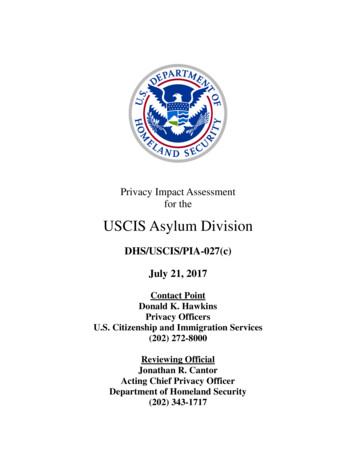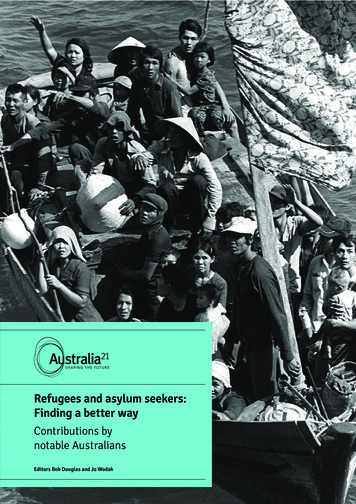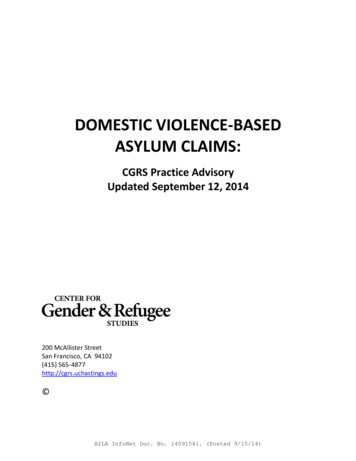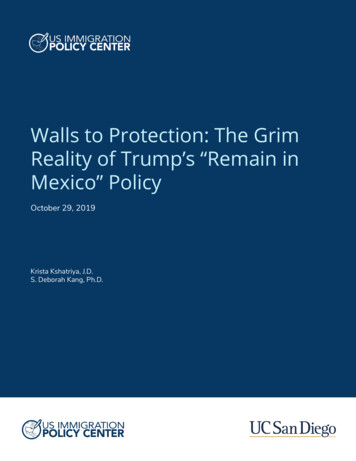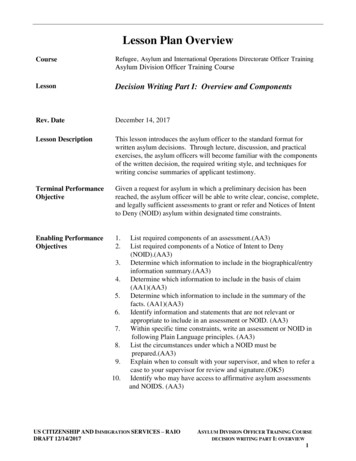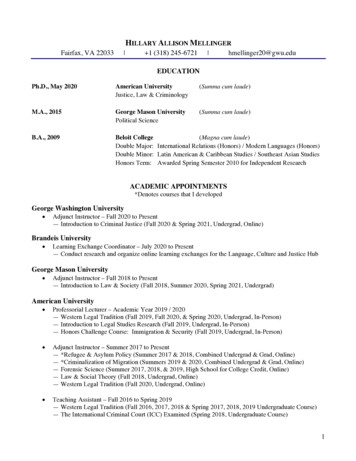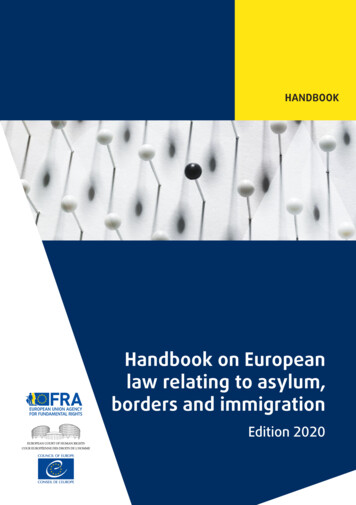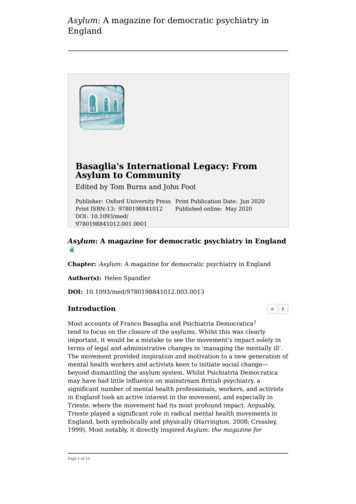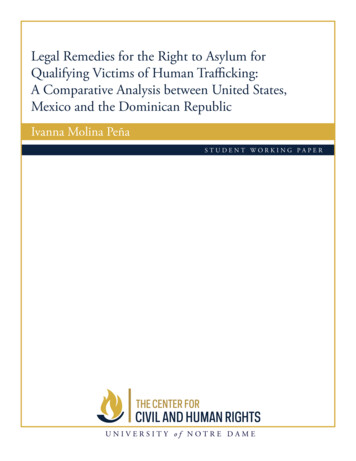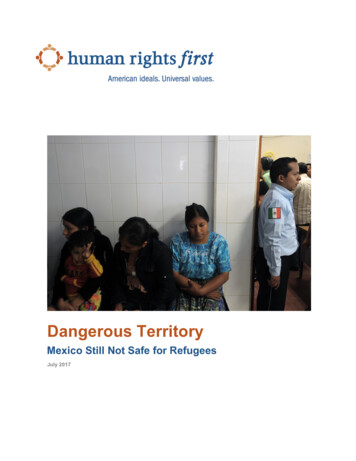
Transcription
Dangerous TerritoryMexico Still Not Safe for RefugeesJuly 2017
ON HUMAN RIGHTS, the United States must be a beacon.Activists fighting for freedom around the globe continue tolook to us for inspiration and count on us for support.Upholding human rights is not only a moral obligation; it’s avital national interest. America is strongest when our policiesand actions match our values.ACKNOWLEDGEMENTSThis report was written and researched by Eleanor Acer andB. Shaw Drake. David Mizner, Meredith Kucherov, andJennifer Quigley contributed edits to the report. SarahGraham designed the report. Caroline Wengeler providedadditional desk research and support. We are grateful for theHuman Rights First is an independent advocacy and actioninvaluable support for Mr. Drake’s fellowship from Equalorganization that challenges America to live up to its ideals.Justice Works and fellowship sponsors Morgan Stanley andWe believe American leadership is essential in the struggleSimpson Thacher & Bartlett LLP. Human Rights First alsofor human rights so we press the U.S. government andthanks the Oak Foundation, the Libra Foundation, theprivate companies to respect human rights and the rule ofHeising-Simons Foundation, the Open Society Policylaw. When they don’t, we step in to demand reform,Center, and the Simmons Sisters Fund of The Dallasaccountability, and justice. Around the world, we work whereFoundation for their support of the organization’s researchwe can best harness American influence to secure coreand advocacy on access to asylum. We are thankful to allfreedoms.the practitioners, organizations, and experts that providedWe know that it is not enough to expose and protestinjustice, so we create the political environment and policysolutions necessary to ensure consistent respect for humanrights. Whether we are protecting refugees, combatingtorture, or defending persecuted minorities, we focus not onmaking a point, but on making a difference. For over 30years, we’ve built bipartisan coalitions and teamed up withfrontline activists and lawyers to tackle issues that demandAmerican leadership.Human Rights First is a nonprofit, nonpartisan internationalhuman rights organization based in New York andWashington D.C. To maintain our independence, we acceptno government funding. 2017 Human Rights First All Rights Reserved.This report is available online at humanrightsfirst.orginformation to inform this report.COVER PHOTO: Jose CABEZAS/AFP/Getty Images
ContentsIntroduction . 1Kidnappings, Disappearance, Trafficking, and Sexual Assault . 3Refoulement and Suppression of Asylum Claims . 4Mexican Asylum System Lacks National Reach andCapacity to Timely Adjudicate Cases . 6Mexican Asylum System Leaves Many Refugees Unprotected . 6Detention Used to Punish Asylum Seekers . 8Detention and Refoulement of Children, Families,LGBTI Persons and other Vulnerable Populations . 9Gaps in Long Term Integration Initiatives . 10Recommendations . 10Endnotes . 12
DANGEROUS TERRITORYIntroduction1press Mexico to “manage” the border without anypublic affirmation of the importance ofEarlier this year the Trump Administration and itsinternational law and treaty commitments thatCongressional allies advanced proposals to foistprohibit the return of refugees to persecution. AtU.S. refugee protection obligations onto Mexicothe June 2017 “Conference on Prosperity andand to block from the United States non-MexicanSecurity in Central America” in Miami, Mexicanrefugees and asylum seekers who pass throughand U.S. authorities agreed to “exploreMexico. These moves would undermine U.S.enhancements to border security,” again withoutglobal leadership and violate American legalmentioning refugee protection.commitments even if Mexico had a strong refugeeprotection system. They are all the moredangerous because Mexico doesn’t. Amid massdisplacement caused by rampant human rightsabuses and violence in the Northern Triangle ofCentral America, these proposals would forcethousands of refugees to return to or remain in acountry deeply unsafe for them.1To assess the degree of refugee protection inMexico and determine how to improve itregionally, Human Rights First researcherstraveled to Mexico in June 2017. They interviewedhuman rights monitors, nonprofit lawyers, U.N.staff, other aid agency staff, the MexicanCommission for Refugee Assistance (COMAR),Mexico’s asylum adjudication agency, and thePresident Trump’s January 25th Executive OrderNational Commission of Human Rights (CNDH).“Border Security and Immigration Enforcement(Their request to meet with the National InstituteImprovements” proposed to return some borderof Migration (INM), Mexico’s immigrationarrivals to “contiguous territories,” such as Mexico,enforcement agency, went unanswered.) Humanwhile they await U.S. immigration court removalRights First also gathered information fromhearings. In the wake of this order and therefugees, attorneys, and aid workers during visitsPresident’s other executive order relating toto Mexico in March and May 2017, and fromrefugees, some U.S. agents on the southernrefugees who, after passing through Mexico,border have told people seeking protection thatreceived assistance through Human Rights First’sthe United States is no longer accepting asylumpro bono legal representation program.seekers and, as documented in a May 2017Human Rights First report, illegally turned someaway in violation of U.S. law and treaties.Human Rights First has concluded that Mexico isfar from a “safe third country” for refugees. Keyfindings:In addition, legislative proposals would changeU.S. law to require asylum denials to manyrefugees who travel through Mexico, even if theylack actual protection there, and allow theSecretary of Homeland Security to declare Mexicoa “safe third country” to which the United Stateswould return refugees, barring them from seekingprotection through the U.S. asylum process.nMigrants and refugees face acute risks ofkidnapping, disappearance, sexualassault, trafficking, and other grave harmsin Mexico. Asylum seekers and migrants aretargeted for kidnapping and killing in Mexico.Some have been trafficked into forced labor.They are targeted not only due to theirinherent vulnerabilities as refugees andIn April 2017, Mexico’s Foreign Minister Luismigrants, but also due to their nationality,Videgaray announced that Mexico wouldn’t acceptrace, gender, sexual orientation, and gendernon-Mexicans turned away or removed from theidentity. Refugee and migrant women andUnited States. Yet the United States continues togirls have been trafficked to Mexico’sHUMAN RIGHTS FIRST
DANGEROUS TERRITORYsouthern border, where they are exploited inrefugees reside. COMAR is massively under-the bars and nightclubs that cater to the manyresourced and lacks the staffing levelspolice, military, and other security forces innecessary to adjudicate these protectionthe area. Even asylum seekers and refugeesrequests in a timely manner, forcing manygranted protection in Mexico remain at riskapplicants to wait long periods.from persecutors with transnational reach.nnDeficiencies, barriers, and flaws in theMexican migration officers deport CentralMexican asylum system leave manyAmericans who have expressed fear ofrefugees unprotected. There has beenreturn despite the country’sprogress in the Mexican asylum system sincenonrefoulement and human rightsits launch in 2011, including a recentobligations. Refugees who fear persecutionalternatives-to-detention initiative andare often deported back to danger. In someincreased recognition rates. However,cases, people in need of protection are notsubstantial deficiencies, barriers, and flawseven aware that they can apply for asylum inpersist. Refugees are blocked from protectionMexico. When asylum seekers express a fearunder an untenable 30-day filing deadline,of return, INM agents often do not take thedenied protection by COMAR officers whosteps necessary to allow them to apply forclaim that refugees targeted by groups withasylum. In many cases, officers activelynational reach can safely relocate within theirdiscourage or pressure Central Americanscountries, and discouraged from pursuingheld in migration detention from applying fortheir claims by INM agents at detentionasylum regardless of their expressed fears offacilities and at the border. The system alsoreturn. In January through October 2016, onlysuffers from a lack of sufficient nonprofit legalfive percent of the 130,000 Central Americanscounsel and exceedingly onerous registrationapprehended in Mexico applied for asylum.2requirements that often prevent lawyers fromOnly 138 of the 35,000 minors from themeeting with or assisting asylum seekers heldNorthern Triangle detained in the first fourin detention facilities.months of 2016 sought asylum, and only 77,or 0.2 percent, received protection.n2nDetention is used to punish people whorequest asylum and as a threat to pressureAs the number of asylum claims filed inpeople who express fear of return fromMexico rises sharply, the Mexican asylumapplying for asylum. INM officers invoke thesystem lacks effective national reach. Fromthreat of months of detention to try to2013 through 2016, the number of asylumdissuade refugees from pursing asylum3claims filed in Mexico rose 678 percent. Inclaims. Those who pursue asylum claims2016, 8,788 people applied for asylum. In thewhile in custody are held for months or longer.4first six months of 2017, 6,835 applied,representing a 100 percent increase over thesame period in 2016. This rate of increaseleads COMAR to expect more than 22,5005asylum applications in 2017. Yet COMARhas offices in only two locations in addition toits Mexico City office. The agency has nooffices in northern states, where manynChildren, families, and other asylumseekers are detained in violation ofMexico’s human rights and refugeeprotection commitments. Mexican law andhuman rights treaties prohibit the detention ofchildren, and detention of asylum seekersviolates human rights and refugee protectiontreaties in most cases, particularly when thatHUMAN RIGHTS FIRST
DANGEROUS TERRITORYdetention exceeds a few days. The conditionsin Mexican facilities have been criticized byMexican and global human rights authorities.3Kidnappings, Disappearance,Trafficking, and Sexual AssaultImmigration authorities have successfullyMigrants and refugees face acute risks oftested community-based alternatives tokidnapping, disappearance, sexual assault,detention programs in Mexico and in othertrafficking, and other harms in Mexico. In 2017,countries.Mexico’s National Commission on Human RightsAs the recommendations at the end of this reportissued a report on mass graves in Mexico, whichmake clear, there is much the Mexicandocumented 312 registered deaths andgovernment, the U.N. Refugee Agency (UNHCR),disappearances of migrants. Between 2009 andand donor states should do to improve refugee2014 another study found 390 mass graves withprotection in Mexico and support the developmentover 7,000 remains, including bodies of suspectedof a fair and effective asylum system. The Unitedmigrants.States and other countries should robustly supportIn 2010, kidnappers massacred 72 migrants inUNHCR’s efforts to enhance the capacity of theTamaulipas after family members failed to payasylum system in Mexico and others in the region.ransoms and the migrants refused to serve asThe United States should take additional steps todrug mules. In 2011, 193 migrants were killed inimprove access to asylum in Mexico andSan Fernando, Tamaulipas, and police officersthroughout the region. Most critically, U.S.were reportedly involved. In 2012, 49 migrantgovernment agencies —which provide significantbodies were discovered in Nuevo Laredo.funding to Mexico for migration enforcement—Human rights monitors report an increase inmust press Mexican authorities to identify andkidnappings, disappearances, and executions ofrefer asylum seekers for protection processing,migrants and refugees in recent years. In somerather than deport them and dissuade them fromcases, organized criminal groups kidnap largeseeking asylum. The United States should alsogroups of migrants, in collaboration withencourage the use of alternatives-to-detention forsmugglers, and in some cases in collusion withasylum seekers.Mexican police or immigration officers.By supporting refugee protection in the region, the2011 and October 2016, the National Registry ofUnited States would enable some refugees—Missing or Disappeared Persons (RNPED)particularly those who do not have family or otherdocumented 29,903 disappeared persons.strong U.S. ties—to choose to seek protection inIn 2016 the International Organization forMexico. But whatever progress Mexico makes onMigration (IOM) received reports of more than 700refugee protection, it cannot justify U.S. abdicationmigrant deaths in Mexico and said that countlessof its own responsibilities. Efforts to returnmore likely go unreported.refugees to—or force them to remain in—Mexico72 shelter in southern Mexico reported eight masssubvert international law, set a poor example forkidnappings of migrants and alleged that Mexicanother nations, and ultimately undermine the rule ofFederal Police officers participated in the events.law. They also clash profoundly with the ideals ofSome migrants and refugees are trafficked intoa nation that has often led globally on refugeeforced labor and some are reportedly enslavedprotection, a nation that President Reagan aptlyand forced to work helping to grow and producedescribed as a “beacon” to people searching fordrugs.67891011161412Between13Also in 2016, the LaKidnappers threaten migrants andfreedom.HUMAN RIGHTS FIRST15
DANGEROUS TERRITORY4refugees, telling them that they will be killed,detention because members of the group they“disappeared” or forced into labor if they or theirhad fled were held in the same detention facility.2517families do not pay a fee.In December 2015, Mexico’s Attorney GeneralAccording to a June 2017 report from the Humancreated a unit to investigate and prosecute crimesRights Center Fray Matias de Cordova in southerninvolving migrants, both as victims and theMexico and Kids in Need of Defense, smugglersaccused. As of September 2016, the unit hadsometime “sell migrant and refugee women andreceived 129 cases. However, lack of resourcesgirls to human trafficking operations for theand delays in operational rules have “preventedpurposes of sexual exploitation.”18In other cases,traffickers force women and girls to engage in sexwork or domestic work to “pay” for their trips.19the Unit from fully focusing on the investigation ofcrimes against migrants,” according to theWashington Office on Latin America (WOLA). InTraffickers also bring girls from the Northernthe state of Coahuila, as of August 2016,Triangle to Mexico’s southern border to exploitprosecutors had charged just one perpetrator inthem in the many bars, nightclubs and restaurantsthe 162 reported cases involving crimes againstfrequented by police, military, and other securitymigrants. In comparison, a June 2017 studyforces in the region.20documented 5,289 incidents of crime againstRefugees and migrants are particularly vulnerableto violence, exploitation and persecution due totheir status as non-nationals lacking legal statusand/or protection. Many refugees and migrantsare also targeted due to their nationality, race, orgender. Those who flee persecution due to theirmigrants in 2016, including 921 crimes againstmigrants committed by federal or state officials.26Discrepancies between the number of crimesagainst migrants documented by shelters andthose investigated by State prosecutors indicatethat nearly half of such crimes go unreported.27sexual orientation or gender identity often findthemselves again targeted in Mexico.21Even asylum seekers and refugees grantedRefoulement and Suppression ofAsylum Claimsasylum continue to be at risk from theirpersecutors in Mexico. Several aid workers andAs party to both the 1951 Convention Relating tomonitors described the transnational reach ofthe Status of Refugees and the Conventioncriminal groups targeting refugees, particularly inAgainst Torture the Mexican government issouthern Mexico but also in other parts of theobligated to prevent the return (refoulement) of22country.Human rights monitors stressed thatany person to a country where they would face28there is a large presence of transnational gangs inongoing threats of persecution or torture.southern Mexico, which have easy access toMexico deports many refugees who are blockedthose fleeing gang persecution in the Northernor discouraged from seeking asylum in Mexico, orTriangle.23One aid worker reported assisting afamily from Honduras who fled after gangmembers killed their children. While in a migrantshelter in southern Mexico, the family saw theirson’s murderer in the same shelter, forcing themto flee again.24Furthermore, in some cases,asylum seekers have accepted deportation fromYet,who do not even know they can apply for asylum.Mexico has deported thousands of NorthernTriangle nationals, even though these populationshave been found to be largely seekingprotection.29Between January 2014 and July2016, Mexican authorities detained and returnedmore than 448,000 migrants but only 6,933, or 1.6HUMAN RIGHTS FIRST
DANGEROUS TERRITORY5percent, applied for refugee status and only 2,982officers themselves have explained to monitors,30lawyers, and aid workers that they tell detaineeswere granted protection.In 2016, just fivepercent of the 130,000 Central Americansapprehended in Mexico applied for asylum.not to pursue asylum requests from detention and31instead to accept deportation. INM officers tellasylum seekers that if they decide to pursueCertainly, many asylum seekers may intend toseek protection in the United States, particularlythose who have family or other close ties there.detention facilities for three months or longer. Insome cases, INM officers explained that, afterHowever, aid workers, attorneys, and humanrights monitors in Mexico report that many CentralAmericans who fear return are not aware they canseek asylum in Mexico, and some are deported byMexican authorities despite their fears of return.asylum they will be held in these migration32deportation, the asylum seekers could try to comeback into Mexico and seek asylum without beingarrested and held in detention.36In a June 2017 report, Amnesty InternationalAs one human rights monitor observed, “there isdocuments asylum seekers’ reports that INMnot an established system to identify people inagents previously deported them withoutneed of international protection.”33informing them of their right to seek asylum.Human Rights First has represented asylumseekers who were deported to their countries offeared persecution by Mexican authorities. In onecase, a woman who had fled Honduras with herchildren was detained by Mexican authorities anddeported back to Honduras two weeks later; inanother case a woman and child who wereattempted to cross to the United States weredeported back to Honduras.comments [about their fear of return] or at timesmade derogatory or mocking remarks aboutthem.” Other INM agents actively discouragedthem from seeking protection. AmnestyInternational found that INM agents fail to followprotection options in Mexico.37While many asylum seekers are deported under aAs many refugees are unaware that they can seekasylum in Mexico—or how to do so, particularlyfrom detention—UNHCR is working to increasethe information provided to Central Americanrefugees and asylum seekers in shelters and34researchers that “INM agents ignored theirprocedures to adequately inform migrants of theintercepted by Mexican authorities as theydetention facilities.Asylum seekers told Amnesty InternationalHowever, attorneys,“voluntary” removal process, many of thesedeportations are not truly voluntary as refugeesacquiesce to removal only under threat of monthsin detention. As one human rights monitor pointedout, “It is not a free choice because they areintimidated into accepting ‘voluntary’ return.”38Such practices of coerced returns constitutemonitors, and aid workers report that manymigrants with protection needs remain unaware of35the asylum process or whether they qualify.Mexican INM officers who work at detentionfacilities encourage asylum seekers to acceptdeportation and to not pursue asylumapplications. Aid workers, human rights monitors,and lawyers consistently report that asylumseekers tell them that INM officers encouragethem to not pursue asylum. In some cases, INMrefoulement. Improper returns are facilitated bylack of information and lack of effectivemechanisms for referring asylum seekers intoasylum proceedings.COMAR officers in Mexican immigration detentionfacilities also reportedly minimize the chances ofreceiving asylum in their communications withasylum seekers. The conditions under whichthese interviews are conducted, sometimes in tinycell-like rooms, and with little or no access toHUMAN RIGHTS FIRST
DANGEROUS TERRITORYcounsel, also discouraged asylum seekers fromseeking protection.396Despite the expected doubling of asylumapplications, COMAR’s 2017 budget is 1.6 million50Recent reports issued by Amnesty International,pesos less than it was in 2015.the Center for Migration Studies, Cristosal, andDue to its lack of resources, COMAR lacks theWOLA have all found that Mexico has violated itsstaffing levels necessary to adjudicate asylumnonrefoulement obligations by deportingrequests efficiently and in a timely manner,protection-seeking migrants to the Northernleaving many asylum seekers waiting longTriangle.40 41UNHCR reports that it is working toperiods. The law provides that asylum decisionsmonitor and identify cases of refoulement atshould be made within 45 days, but many officersMexico’s southern border. In two instances, theare seeking extensions, leaving asylum seekersgovernment of Mexico agreed to take backwaiting three months and often much longer.asylum seekers who had been refouled, thoughJune 2017 study by WOLA found that asylumUNHCR monitors believe there are many moreseekers in southern Mexico were commonly42cases of refoulement.51Awaiting over 45 days for an asylum interview andthat between December 2016 and February 2017Mexican Asylum System LacksNational Reach and Capacity toTimely Adjudicate CasesThe number of asylum applications filed in Mexicohas risen steadily. Between 2013 and 2016, thenumber rose by 678 percent.43In 2016, 8788people applied for asylum and in the first threemonths of 2017, 3,543 applied.44This representsa 100 percent increase in asylum applicationsover the same period in 2016 and leads COMARto expect over 22,500 asylum applications in452017.asylum interviews “were few and far between” formigrants stranded at major migrant shelters near52the southern border.In addition to its Mexico City office, COMAR hasonly two other offices, both in Southern Mexico.Many COMAR officers conduct adjudicationinterviews by telephone due to their lack ofpresence in most of the country.53COMAR doesnot have offices in northern Mexico, includingmajor cities such as Guadalajara and Monterey,where an increasing number of refugees settle.COMAR also has no presence along the northernborder, where some refugees seek status afterbeing turned away by the United States. COMARDespite this significant increase in asylum filings,also does not have a permanent office in theCOMAR remains deeply understaffed. COMARsouthern border state of Tabasco, where manyhas only 28 officers conducting protectionasylum seekers are located.adjudication interviews.4654UNHCR has providedsupport to help add 29 COMAR officers.47Yeteven with UNHCR’s support, COMAR will remainexceedingly understaffed. One aid worker saidMexican Asylum System LeavesMany Refugees Unprotectedthat COMAR officers are “crushed” by the numberof cases.48Officials confirmed that most COMARagents work more than 12 hours per day and49burnout causes frequent turnover.Mexican lawyers, aid workers, and nonprofit legalproviders report that they regularly see refugeesdenied asylum mistakenly or unfairly in theMexican asylum system. They report, forexample, that asylum adjudicators at COMARHUMAN RIGHTS FIRST
DANGEROUS TERRITORYoften deny refugees asylum on the erroneousassertion that they can safely relocate within smallcountries, such as El Salvador or Honduras,without risk of harm from persecutors who havenational reach.The asylum system also lacks effective casetransfer procedures, so when an asylum seekermoves within the country—for instance to joinfamily or attempt to evade their persecutors—theyoften must reapply for asylum. When they do, theymay find themselves barred by the 30-day filing56Barriers and Gaps in LegalRepresentationThere are very few lawyers trained in refugeelaw who can represent asylum seekers in55deadline.7Human rights monitors, attorneys, andaid workers report that the 30-day deadline leavesmany refugees blocked from asylum. Forexample, it often takes asylum seekers more than30 days just to reach Mexico City or points north.Mexico. This lack of legal services andsubstantial gaps in funding for nonprofit legalproviders leave the vast majority of asylumseekers to navigate a complex system alone.This gap in counsel, along with proceduralhurdles—such as an extremely short filingdeadline and complex case transferprocedures—block many unrepresentedasylum seekers from full adjudications of theirprotection needs.60The few attorneys who dostruggle to represent asylum seekers also faceserious barriers to accessing clients held inAttorneys and aid workers assisting refugees alsodetention facilities. For example, cumbersomeraised serious concerns about the quality andprocedures for recognition of legalfairness of COMAR asylum adjudications. Withrepresentation before both COMAR and INMthe agency massively understaffed, andprevent attorneys from visiting clients inadjudicator’s salaries reportedly low, the turnoverdetention and appearing during initial asylumrate for COMAR adjudicators is high.57New61interviews.personnel are in need of additional training,according to multiple experts.client’s wife and child were denied asylum even58Adjudicators sometimes fail to make individualcase-by-case determinations. They copy-and-though they had fled the same persecution thatformed the basis of the client’s claim.62paste information and explanations from priorAs a result of flawed initial decisions, appeals aredecisions relating to other asylum applicantsoften necessary. Yet there are numerous(leading to major inaccuracies in written asylumdeficiencies in the appeals procedures. The initialdecisions), fail to consider gender or child specificreview is made by COMAR, the same agency thatprotection issues, only interview the father inissued the asylum denial that is the subject of thecases where the wife or children have testimonyreview. COMAR does not review the substance ofhighly relevant to the protection claim, andthe initial decision. Instead, it corrects onlyconduct flawed county conditions analysis, suchprocedural errors, such as the obvious cut-and-as mischaracterizing violence or threats withpaste mistakes that result in the wrong applicantor country being analyzed in the original decision.59national reach as “localized.”The lack of quality and fairness in decisionmaking can lead to absurd and inconsistentresults. For example, a Mexican lawyer reportsthat while his client, a Haitian national who fledpersecution, was granted refugee status, hisThe next appeals level involves review by anadministrative law tribunal that lacks experiencewith asylum, refugee, and human rights law.63Inorder to succeed in correcting mistaken asylumdenials on appeal, legal representation isessential. However, very few lawyers in MexicoHUMAN RIGHTS FIRST
DANGEROUS TERRITORY8have experience representing asylum seekersdid not provide beds, banned visitors, failed toand only a handful of non-profit organizationsappropriately separate women and children fromhandle asylum appeals.64The rate at whichadult males, and lacked medical and security72refugees are granted asylum has increased, risingstaff.from 34 percent in 2014, to 39 percent in 2015, toand other cruel, inhuman and degrading42 percent in 2016 and through March 2017.65The U.N. Special Rapporteur on Torturepunishment reported in 2014 that he receivedStill, these rates are low given the highreports of beatings, threats, humiliation and insultspercentage of individuals fleeing acute violence.66Of 202 asylum requests supported by La 72shelter in Southern Mexico between January andJune 2017, none were granted refugee status and67only six were granted complementary protection.Low recognition rates—along with asylum denialsof refugees with well-founded fears of73from migrants held in detention facilities.It is extremely difficult to pursue an asylum claimfrom detention. As one attorney told HumanRights First, “Detention is the rule not theexception in Mexico and it greatly impacts theability to seek asylum.”74persecution—are likely to discourage many fromAs outlined above, INM officers invoke the threatapply
Mexico. When asylum seekers express a fear of return, INM agents often do not take the steps necessary to allow them to apply for asylum. In many cases, officers actively discourage or pressure Central Americans held in migration detention from applying for asylum regardless of their expressed fears of return. In January through October 2016, only
